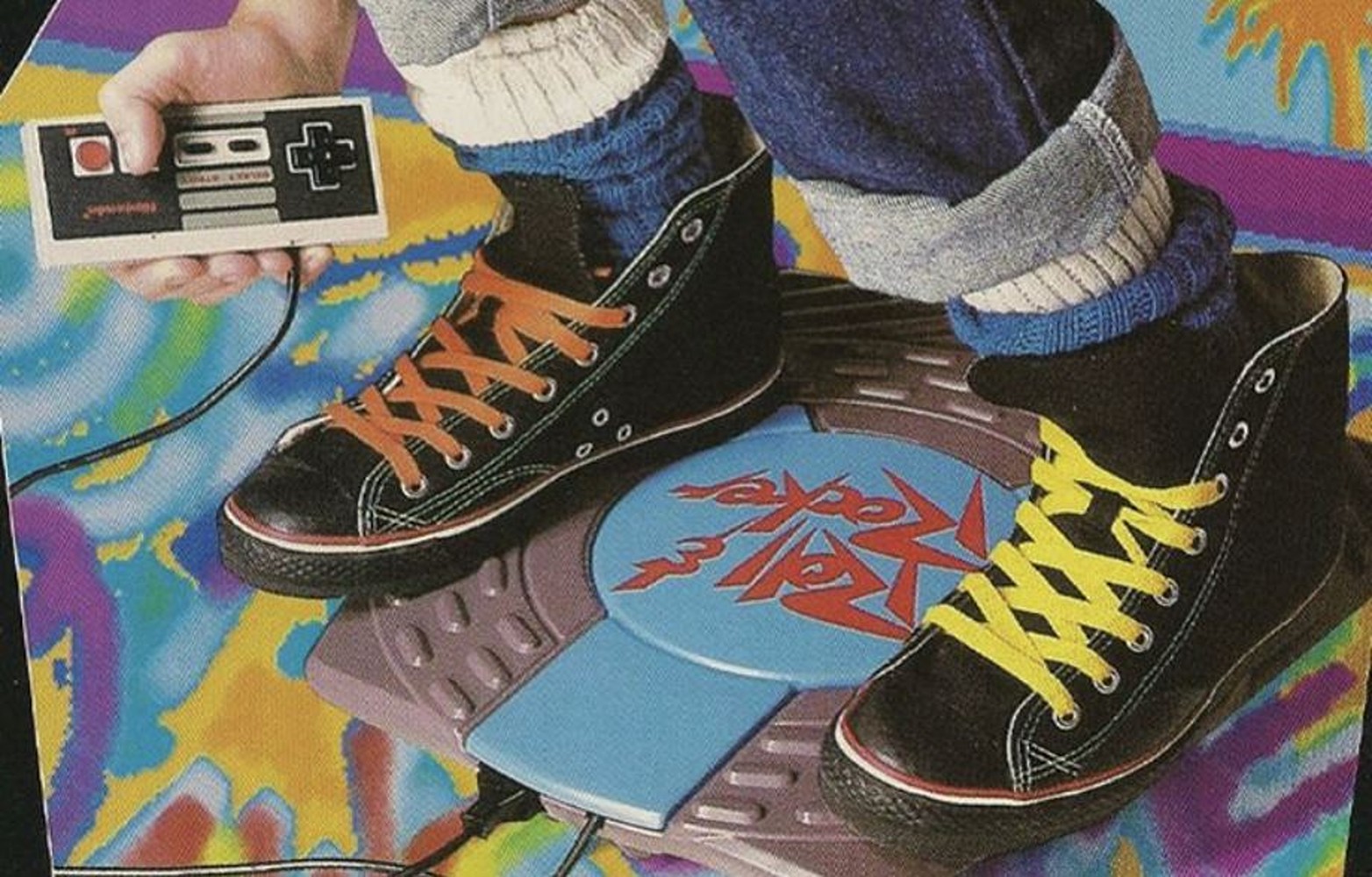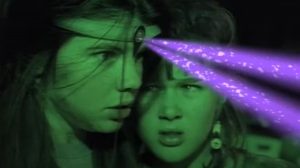
When the Nintendo Entertainment System hit back in the ’80s, we saw this influx in the concept of gaming accessories. The light gun was iconic, allowing you to shoot down ducks and cowboys. The Power Glove and ROB the Robot looked godly, but worked like garbage. The Power Pad was a brilliant novelty of the time. The Game Genie was a literal game-changer. Playing games was one thing, but HOW we played the games was another avenue to be explored.
Not every accessory made such a footprint in video game history. They couldn’t all be shilled by Lucas during a throwaway scene in The Wizard. Some concepts fell into obscurity, like when Atari tried to make a headband controller for the 2600 that would control the game based on your “thoughts.”
I really should include the Atari Mindlink on this list of forgotten video game accessories, but unfortunately, it never got released. And for good reason! Still, I just had to mention it because…what the hell?
Photo: @VideoKraken
Atari 2600 Stick Station (1983)
In the days of the Atari 2600, playing around with its joystick could occasionally do a number on your hands. And so, they released a way to keep the stick stationary…by shoving it into an oversized plank.
While I understand the logic behind it, I can’t help but find the station comedic. It’s just a big hunk of wood with a hole in it and a logo in the corner. They quickly realized it was way easier to just throw some suction cups on the bottom of the controllers instead, making the Stick Station a very short-lived product. The NES had its own version of this called the Speedboard, which simply made controlling the games feel way worse.
Exciting Boxing’s Inflatable Controller (1987)
In 1987, Konami released a game called Exciting Boxing for the Famicom. At first glance, it appears to be a pretty straightforward genre title. Like just about every boxing game, you go through a series of increasingly difficult opponents, which, in this case, included a Clubber Lang knockoff and a boxing luchador (beating Super Punch Out’s Masked Muscle to the…umm…punch by several years). The difference is that you wouldn’t be using a regular controller to dodge, block, and punch.
Instead, your controller is an inflatable punching bag with the image of a boxer on it. By punching this big balloon, your hits would be reflected in the game itself. In a weird way, it’s like an unholy hybrid of Punch-Out! and Duck Hunt. The inflatable controller could only be used for Exciting Boxing specifically, and the whole setup is worth a pretty penny if you’re trying to track down your own copy.
SegaScope 3D Glasses (1987)
The original Sega Master System experimented with the idea of 3D gaming through a special visor called the SegaScope 3D Glasses. This was more than just a regular cardboard pair of 3D glasses, as you had to plug the device into your console and watch the game through two constantly flickering lenses. While it did work as intended, it often cut a game’s frame rate by half.
The glasses can only be used with the first version of the Master System, as the necessary port was done away with in updated versions of the console. It was also only compatible with eight games, including Line of Fire, which came out way later in 1992.
Around this time, the Famicom had its own counterpart in the Famicom 3D System, but it was a complete bust and never left Japan. It was also compatible with Falsion, which is one of the better 8-bit games to never make it to the United States.
LJN Roll ‘n Rocker (1989)
Devices like the Power Glove and U-Force tried to create scenarios where you could control your games in a brand-new way. The Roll ‘n Rocker didn’t seem to fully understand that novelty, as it was only based on the direction pad. Using the accessory still required you to use a controller for the A, B, select, and start buttons.
Otherwise, the device was a teetering platform that you had to tilt in different directions in order to press up, down, left, or right. It was certainly an idea, but it was not one that gave you any real advantage in the actual games. It just made games harder to play, especially with how easy it was to fall off. Not to mention balancing in the center and not pointing in any direction wasn’t nearly as easy as “not pressing any buttons.”
Game Gear TV Tuner (1991)
At the time, the Sega Game Gear’s claim to fame was that it had color when the Game Boy did not. That was pretty much it. While it wasn’t a bad handheld, it just doesn’t stand out all these decades later. But it did have one neat advantage in the form of an attachment that allowed you to watch TV on the go.
Portable TVs, especially this size, were a rarity in the early 90s, so this was a cool little addition that helped the Game Gear pop. Granted, the Game Gear’s battery life was already short-lived before turning it into a television, making it die out quickly, but it was lowkey revolutionary for its time.
Aladdin Deck Enhancer (1992)
When talked up in magazines, the Aladdin Deck Enhancer sounded too good to be true. It was touted as an attachment to the NES that would enhance 8-bit games and supposedly make them on par with 16-bit games. This was just bullshit marketing and the product ended up in this weird limbo where it was mass-produced and packaged, but its company (Camerica) went under right as it was coming out. The Aladdin died before anyone even noticed it existed.
Under the “enhancement” smoke and mirrors, the actual concept behind the Aladdin was brilliant. Camerica, who were already making unofficial NES games, understood that much of the cost in making cartridges was manufacturing the identical chips and guts that allowed games to be playable on the NES in the first place. By putting all that stuff in the Aladdin and releasing individual game cartridges that only had the ROM information, you could save a ton of money and afford to release these games for $20 a pop!
Had things not gone so badly, the plan was to produce Aladdins for SNES and Genesis.
SN/SG ProgramPad (1993)
Released for the 16-bit consoles, the ProgramPad was a controller with a neat LCD screen that allowed rapid-fire, “slow motion” (ie. repeatedly pressing start), and sequence programming. By that, I mean that you could input a sequence of button presses and essentially combine them into a single button. This was used explicitly for fighting games, as I can’t for the life of me figure out why else you would need this.
It definitely was useful for fighting games, though. Doing the Dragon Punch motion in Street Fighter II (forward, down, down/forward + punch) could be unreliable on the D-pad, as was Zangief’s spinning piledriver (full circle clockwise + punch). It would be more helpful for SNK fighting games and Primal Rage, where the inputs for special moves were too complicated at times. Or maybe you just want to spam the same Mortal Kombat Fatality over and over again without memorizing it.
Saitek’s Booster Boy (1993)
Ever since the Game Boy was released, there were accessories that helped deal with its various limitations. Companies released everything from magnifying glasses and built-in lights that were all intended to improve the game-playing experience. Then there’s Saitek, who decided that the Game Boy was actually Tony Stark and needed its own Hulkbuster armor.
The Booster Boy takes the Game Boy and puts it in a giant case that increases the button size, adds a retractable magnifying glass, flashlight, and speakers. There’s even a compartment in the back to hold a couple of spare games. It’s a ridiculous hunk of plastic that can certainly change the way you play the classic Game Boy, but unless you’re MC Hammer, forget about ever getting that thing to fit in your pocket.
Photo: Hit-Japan Video Games and Anime
Capcom Pad Soldier (1993)
Retro gaming controllers had a hard time keeping up with the early fighting game boom. The Genesis only had three buttons on it, though they were at least able to later release a six-button controller to correct that. The SNES had six buttons, but with two of them being shoulder buttons, that made things a bit awkward. Doable, absolutely, but still awkward at times.
These days, fighting game fans tend to use arcade sticks to better control the action. Back then, though, Capcom decided to meet that solution halfway with the Capcom Pad Soldier. It was a rather unique controller that had a single handle on the left side with the D-pad, select, and start on top of it. Adjacent were the six main buttons bunched together, giving the player better access. A novel idea, but a bit too small to work as well as it should. You feel less like you’re typing at a weird angle instead of pressing buttons.
Aura Interactor (1994)
Compatible with the SNES and Genesis, the Aura Interactor may look a little silly, but it’s a sound idea that I’m surprised we don’t see more of in the present.
It was basically a backpack version of a Rumble Pack that was based entirely on taking damage. Whenever your character got hit, feedback would be sent to the Aura Interactor and it would vibrate. It was the sensation that you were taking damage without the pesky excruciating pain part of it.
Of course, the technology wasn’t smart enough to know what exactly was supposed to be hurting you. If you’re playing Mortal Kombat II, punching someone was just as potent as getting punched by someone. Still, if it wasn’t for the $100 price point, this could have become a bigger deal.
Sony Glasstron (1996)
The Sony Glasstron could be considered something of a precursor to the PSVR. It didn’t feature any virtual reality technology, but it did succeed in taking the TV screen and shoving it directly into your eyes. It was essentially a big visor that broadcasted whatever game you were playing, claiming to replicate what it would be like to experience a 52-inch TV from six and a half feet away. They made five different models for this thing, and it cost a whopping $500 to enjoy the sensation of annihilating your eyes with the “best” of them.
Yes, it turns out that sitting directly in front of the TV wasn’t the best way to play games for many. In fact, the accessory had a failsafe built in that made sure to turn itself off if you played for more than a couple hours with it on because that cannot be good for your vision. Then again, I kind of want to pop some Dramamine and use this thing to watch Hardcore Henry.
Game Boy Pocket Sonar (1998)
Initially, I was going to have a catch-all entry for the different fishing controllers. The Nintendo 64, Switch, and Dreamcast all had their own special controllers for fishing games. However, the Game Boy Pocket Sonar was different and more outlandish because instead of helping you find virtual fish, it was a tool to help you track down actual fish in real life with an actual sonar attachment.
Released only in Japan by Bandai, the Pocket Sonar was a tool to help you out during fishing trips. It also had a fish encyclopedia built in and a fishing game in case you, for some reason, wanted to use your Game Boy to play video games. Such a crazy use for the Game Boy. Just makes me want to sit back and fish with my Game Boy while watching TV off my Game Gear.
Steel Battalion Controller (2002)
First released for the original Xbox, Steel Battalion was, on the surface, a gritty mech pilot simulator. What sets it apart from other games of that type is that you had to use a very special controller made specifically for the game in order to properly play it. By controller, I mean a massive dashboard with two joysticks, 35 buttons, and three pedals. Capcom simply did not need to go this hard, but by God, they went nuts with this one. They really wanted to be as immersive as possible.
For some gamers, playing this game is a white whale. Not only is it hard to get your hands on this massive, badass-looking gimmick device, but it also means getting your hands on an original Xbox. There is no backward capability with the Xbox 360. Instead, the Xbox 360 gave us a sequel called Steel Battalion: Heavy Armor, but that was a Kinect game, so you can imagine what kind of letdown it was.
Wii Cooking Mother Kit (2004)
Peripheral designers loved to insert the Wii controller into various objects in the hopes of making games more immersive. For instance, instead of the Wii’s Guitar Hero guitar peripheral being a standalone controller like on other consoles, it featured a slot designed for the base Wii controller and worked through that. Even the Wii Mario Kart game had a steering wheel accessory that played with the console’s motion controls in a satisfying way.
Then there’s the Wii Cooking Mother Kit for those playing Cooking Mama. It’s a big, plastic Swiss army knife for cooking that you attach to your Wii remote to presumably make the gameplay more fun. It has a frying pan, knife, fork, and spatula. Many online reviews aren’t too kind to it, calling it cumbersome and rather unnecessary, but they get points for trying.
Buzz! Buzzers (2005)
As with the last entry, there are a lot of controllers and peripherals based on objects you’re supposed to be pretending to be using. The immersion starts to lap itself when we get to this controller, which allows you the joy of…pressing a button. How novel. To be fair, it is a big button.
For about five years, the Buzz! quiz series was littering the market with over a dozen installments across the PlayStation 2 and PlayStation 3. To add to the game show illusion, the players would get four buzzer controllers to play along with. Other quiz games would utilize the controller, such as Who Wants to be a Millionaire: Party Edition and Disney Think Fast.
The post 15 Forgotten Video Game Accessories appeared first on Den of Geek.






